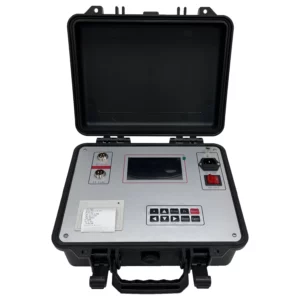Turn ratio testers handle capacitive loads during testing by employing techniques to mitigate the impact of capacitance on measurement accuracy. Capacitive loads can affect the accuracy of turn ratio measurements in transformers.
Here’s how testers manage this issue:
- Low-Frequency Testing: Turn ratio testers often operate at low frequencies, typically between 50 Hz to a few hundred hertz. This frequency range minimizes the impact of capacitance on the measurement, reducing the capacitive reactance and its influence on the transformer under test.
- Phase Compensation: Some advanced turn ratio testers incorporate phase compensation techniques to account for phase shifts caused by capacitive loads. These compensations help correct measurement errors arising from capacitive effects.
- Guard Circuits: Testers may include guard circuits or techniques that isolate the measurement circuitry from stray capacitance. This isolation prevents stray capacitance from affecting the accuracy of the turn ratio measurements.
- Balancing Networks: Some testers utilize balancing networks or compensation circuits that neutralize the effects of capacitance, ensuring accurate measurements even in the presence of capacitive loads.
- Measurement Algorithms: Testers use sophisticated algorithms that can distinguish between the actual transformer turns ratio and any effects caused by capacitive loads. These algorithms help compensate for capacitance-induced errors in the measurement.
- Zero Phase Angle: The tester may be designed to maintain a zero phase angle during measurements, minimizing the influence of capacitive loads on the phase relationship and ensuring accurate readings.
- Calibration and Standards: Calibration processes account for the impact of capacitive loads on measurements. Calibration procedures are performed using known standards and compensations to ensure accurate readings despite capacitance effects.
- Optimized Test Parameters: Testers allow for adjustments in test parameters such as test voltage, frequency, and phase settings. Optimization of these parameters based on the specific transformer characteristics helps mitigate capacitive load effects.
- Interpretation and Analysis: Skilled operators interpret the measurement results, considering the possibility of capacitive load effects. They use their expertise to distinguish genuine turns ratio values from any distortions caused by capacitance.
By implementing these techniques and methodologies, turn ratio testers aim to minimize the influence of capacitive loads on measurements, ensuring accurate determination of the transformer’s turns ratio despite the presence of capacitance in the system under test.
What are the advantages of using turn ratio tester or higher frequency AC testing?
Using a turn ratio tester or higher frequency AC testing offers several advantages over traditional low-frequency testing when assessing transformer characteristics:
- Improved Sensitivity: Higher frequency testing can enhance sensitivity to detecting winding defects or faults in transformers. It can identify issues that might not be apparent in low-frequency testing, leading to more accurate diagnostics.
- Reduced Test Time: Higher frequency testing typically requires shorter test durations compared to low-frequency tests. This can save time during testing procedures, increasing overall efficiency.
- Effective Detection of Winding Displacement: Higher frequency testing can better detect winding displacement or asymmetry in transformer windings, enabling early identification of potential faults.
- Enhanced Capacitive Effect Mitigation: While capacitance can impact measurements, higher frequency testing can mitigate the effects of capacitance on measurements, turn ratio tester resulting in more accurate readings despite capacitive loads.
- Improved Signal-to-Noise Ratio: Higher frequency signals often have a better signal-to-noise ratio, reducing interference and improving the accuracy of measurement readings.
- More Accurate Diagnosis: Higher frequency testing can provide finer detail in assessing the transformer’s condition, offering more precise diagnostic information about the winding structure, insulation condition, and potential faults.
- Capability for Multi-Functional Testing: Some turn ratio testers capable of higher frequency testing may also perform additional diagnostic tests simultaneously, such as insulation resistance, resistance, and excitation current measurement, providing comprehensive transformer diagnostics.
- Effective for Modern Transformers: Modern transformer designs with complex winding configurations and materials can benefit from higher frequency testing due to its improved sensitivity and ability to detect nuanced faults.
- Adaptability to Different Transformer Types: Higher frequency testing can be suitable for various types of transformers, including distribution, power, and specialty transformers, offering a versatile testing solution.
- Compliance with Industry Standards: Some industry standards or specifications require or recommend higher frequency testing for specific types of transformers, ensuring compliance with these standards.
While higher frequency testing offers several advantages, it’s essential to note that the choice between high-frequency and low-frequency testing depends on the specific characteristics of the transformer being tested, the diagnostic requirements, and adherence to industry standards or specifications. Both methods have their unique applications and benefits.
